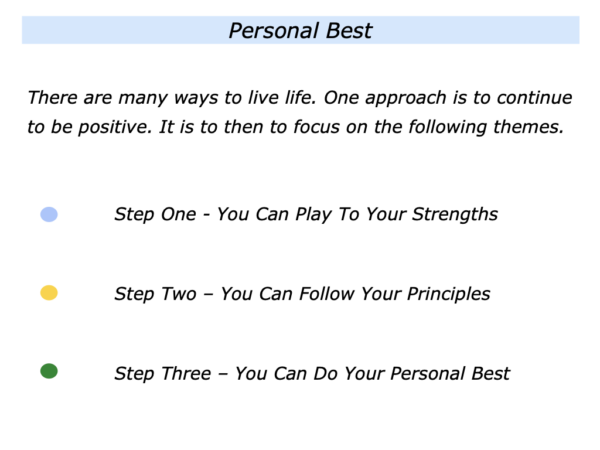
There are many ways to live life. One approach is to continue to be positive. It is then to play to your strengths, follow your principles and do your personal best. Let’s explore how it is possible to follow these themes.
Step One – You Can
Play To Your Strengths
This step involves doing what you do best. It involves building on your strengths, following your successful style and aiming to achieve your picture of success.
There are many ways to take this step. Here is an introduction to some of the most common ways that people focus on this theme.
The Strengths Approach
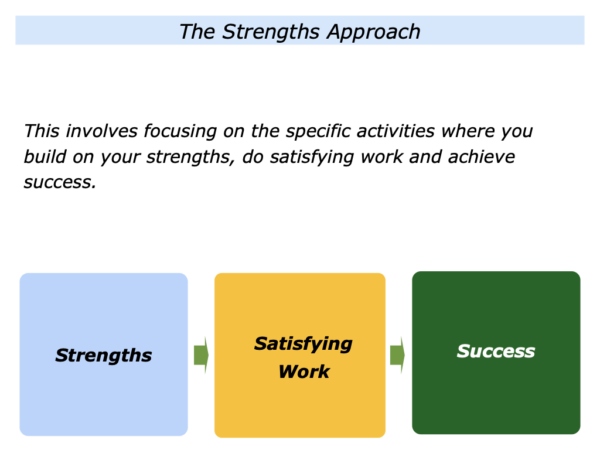
This is the classic approach to doing superb work. It is to focus on the specific activities where you build on your strengths, do satisfying work and achieve success.
The next step is to keep putting yourself into situations where you can do superb work. You can then keep improving on the way to fulfilling your potential. Here is an exercise on this theme.
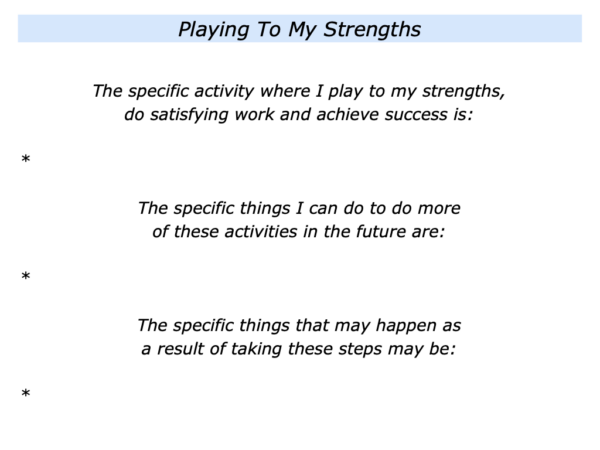
The Sparks Approach
Peter Benson was a pioneer of this approach. Much of his work focused on helping children and teenagers but the principles he outlined can be applied to people of all ages.
He and his colleagues at the Search Institute focused on the times when young people came alive. Much of this work was around the theme of sparks. Peter described these in the following way.
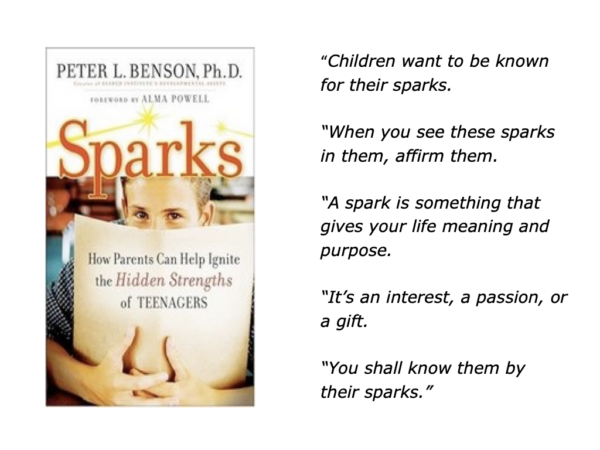
Peter looked for the good in everybody and everything. Whilst being a rigorous researcher, he conveyed his findings about people in a compassionate and inspiring way.
Joining the Search Institute in 1985, he played a key part in pioneering Positive Youth Development programmes across the world. Here is an extract from the Institute’s web site.
Sparks are the hidden flames in kids that excite them and tap into their true passions. Sparks come from the gut. They motivate and inspire. They’re authentic passions, talents, assets, skills, and dreams.
Sparks can be musical, athletic, intellectual, academic, or relational; from playing the violin to working with kids or senior citizens. Sparks can ignite a lifelong vocation or career, or balance other activities to create an emotionally satisfying, enriched life.
Sparks get kids going on a positive path, away from the conflicts and negative issues – violence, promiscuity, drugs, and alcohol – that give teens a bad name and attract so much negative energy.
Peter defined thriving as feeling fully alive, happy and, hopefully, giving to others. He described this approach in the article Thriving Starts On The Inside. Here are some excerpts.
The idea of spark is very much like the idea of spirit. The word spirit comes from Latin and means ‘my breath, put into the world with vigour and courage.’ Your breath, your essence, your spark.
Most of us, however, discover our spark between the ages of 10 and 20. You know it when you feel it. That is, you know it when you are doing something that makes you feel whole, when time stands still, when just doing it or being it is its own reward.
Being great at it or impressing people with it is not the point. Just knowing it, affirming it and putting it into play is the point.
Youth, when talking about their spark, almost always use romantic language in describing it. They say things like, “I love it when I’m playing the piano,” or “I cherish the moments each day when I can help someone.”
Thriving starts on the inside, with the knowledge and affirmation of your spark and the courage to put it into play. That’s how we fall in love with life. The spark is a seed waiting to find fertile soil and a chance to flower. Name it. Love it. Use it to light up our world.
Peter died at the age of 65 in 2011. The Search Institute described him in the following way.
An inspiring leader who devoted his own life to making the world a better place for families, schools and communities.
Neal Starkman also provided a view of Peter’s work. Writing on his blog, he paid the following tribute.
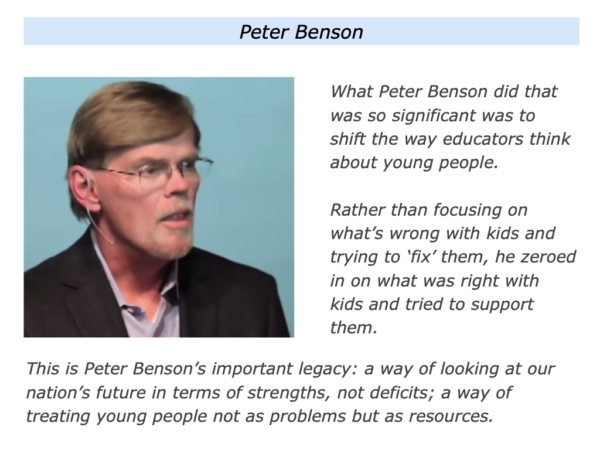
People demonstrate sparks throughout their lives. During a workshop for 40 people, for example, I asked each of them to make a flip chart of the following exercise.
They put these around the walls, filling the whole room with their sparks. This provided lots of information for them to build on during the session and afterwards with their families. Here is the exercise.
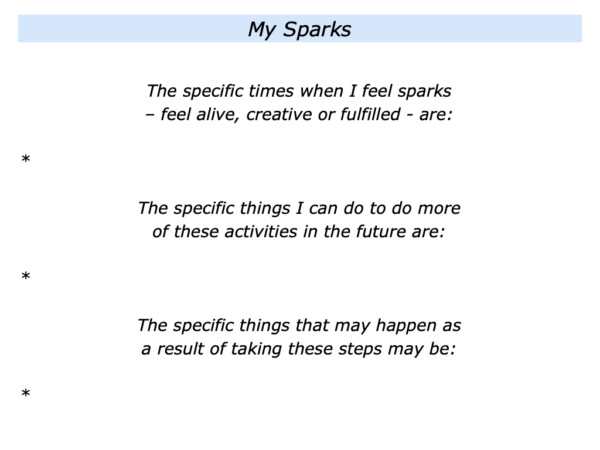
The Sweet Spot Approach
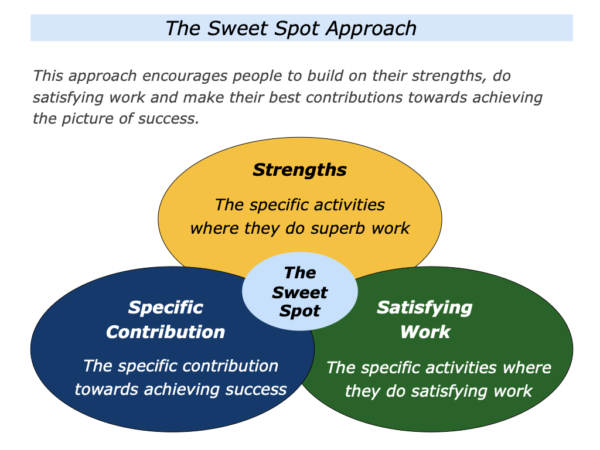
This is an approach that can be used by individuals, teams and organisations. It encourages people to build on their strengths, do satisfying work and make their best contributions towards achieving the picture of success.
The sweet spot concept stems from sport. Since then it has been applied to many other areas of life. Here are some definitions.
The point or area on a bat, club, or racket where it makes most effective contact with the ball.
The particular situation or combination of things that is the best and most effective possible.
The spot where you do something that may appear effortless but sometimes produces the most effective results.
Some elements of this approach have been used in career development workshops since the 1960s. It encourages individuals to do what they do best and make their best contributions to a team or organisation.
The approach is obviously related to the Japanese concept of Ikigai. But it does not necessarily cover their purpose, vocation or mission on the planet. When appropriate, however, these are themes I sometimes explore with a person. This involves focusing on the following themes.
Strengths. The specific activities where they do superb work.
Satisfying Work. The specific activities where they do satisfying work.
Specific Contribution. The specific contribution they can make towards helping people, the team or the organisation to achieve success.
Over the past fifty years I have worked with many people who have used this approach. The follow section describes some of these individuals.
Jack – Being A Specialist
Jack was unhappy in his role as Chief Operation Officer for a worldwide digital company. He had risen through the ranks by being good at solving technical problems and developing software.
Being ambitious, he was delighted when offered the COO role. This came with status – being a member of the C Suite – a pay rise and a number of shares. Unfortunately the role also involved certain aspects that did not play to his strengths. He was expected:
To manage multiple problems that often involved fire-fighting;
To deal with emotional issues as well as technical issues;
To manage people who had lower quality standards than himself and also be on duty 24/7.
Jack also had a young family and felt stretched. This led to him occasionally having outbursts that did not help himself or others. He was quite traditional in some ways. Whilst recognising it would be good for him to revert to a specialist role, he did not want a drop in status.
He and the CEO explored ways he could play to his strengths and also help the company to achieve success. This eventually led to him taking an individual specialist role. This involved him being able:
To do specific project work with certain departments across the world;
To develop pacesetting technical solutions that helped their clients to achieve success;
To maintain his shares and salary but only attend the C-Suite meetings when appropriate.
This proved to be a win-win. The company got the best use of his skills and it resulted in getting increased orders from the customers with whom he worked. Jack was able to do stimulating work, set specific goals and deliver success. This also benefited both his family.
Anna – Being A Chief People Officer
Anna had spent a number of years doing freelance work. Previously a head of HR, she had done projects helping companies to shape their cultures. She found this relatively fulfilling but missed leading a team.
Bearing in mind her strengths, she took a proactive approach to finding a full-time role that would be more satisfying. This led to one of her previous managers – who was now a CEO – asking her to consider joining their company as the Chief People Officer.
Such a role calls for a person demonstrating certain strengths in order to deliver success. They need to be able:
To clarify the CEO’s philosophy, principles and picture of success regarding the company’s people strategy;
To communicate this approach and lead a HR team that successfully implements the key principles regarding the company’s people’s strategy;
To embody the ethic of continuous improvement and continue to deliver the company’s people strategy.
Anna scored at least 8/10 in each of these areas. Working alongside the CEO, she implemented a strategy that enabled employees to develop a people and as professionals.
There are many ways to apply the sweet spot approach. You can use it:
To clarify how you can continue to do satisfying work;
To help other people – such as your children, friends or customers – to do satisfying work;
To help people in your team or organisation to do satisfying work and make their best contributions towards achieving the picture of success.
If you wish, try tackling the exercise on this theme. This invites you to describe how you may want to use elements of the sweet spot approach. It invites you to complete the following sentences.
The Pattern
Recognition Approach
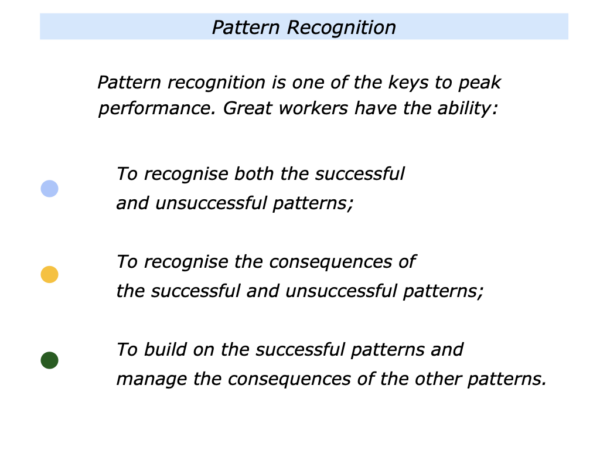
Great workers are good at seeing patterns in the areas in which they excel. Going into a situation, they clarify the results to achieve. They then scan the situation and take the following steps.
They look for how people are behaving or what is actually happening;
They look for both successful and unsuccessful patterns;
They look for how it is possible to build on the successful patterns and manage the unsuccessful patterns.
Great workers sometimes use this framework. They may look for different things, however, depending on whether they aim to see patterns followed by people or patterns in other situations. Here are some of the themes they may explore.
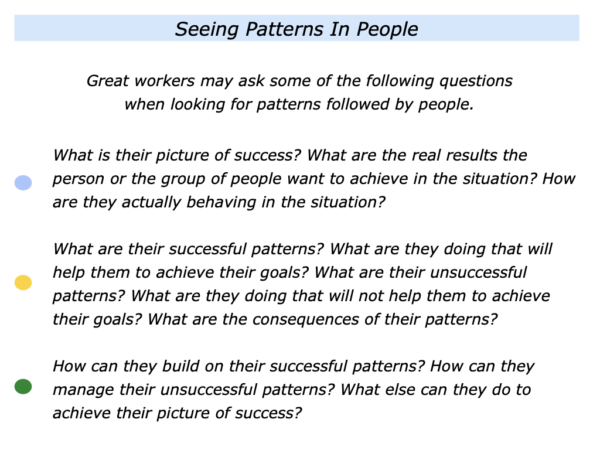
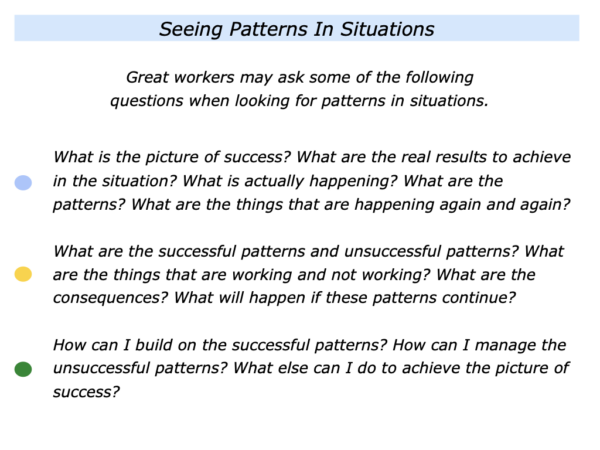
Such workers actually look at what is happening rather than rush into interpreting events. They then use their skills to deliver success.
Different people apply these skills in different situations. One mentor explained their approach in the following way.
“I used to do lots of team workshops. Whilst these often helped people to deliver results, I realised that I was better doing individual mentoring sessions.
“During the one-to-one meetings I found it relatively easy to find people’s successful and unsuccessful patterns. I was then able to provide them with tools they could use to achieve their goals.”
Some people are good at recognising patterns in counselling situations; some in technical situations; some in sporting situations. Some people are good at seeing patterns in financial and investments situations. They then aim to use their skills to deliver success.
Let’s return to your own life and work. What are the situations in which you are good at seeing patterns? These could be when you are working with people or entering another kind of situation.
How can you put yourself into more of these in the future? How can you continue to build on your skills and deliver success in these situations? What will be the benefits of taking these steps?
If you wish, try tackling the exercise on this theme. This invites you to complete the following sentences. We will then move on to the next step involved in performing to your potential.
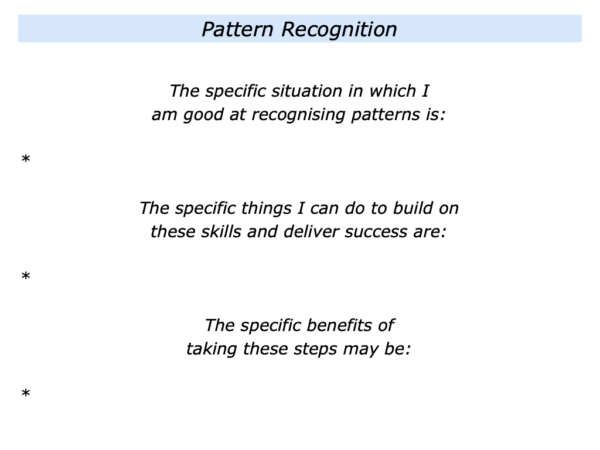
Imagine that you have focused on a specific activity where you can play to your strengths. If appropriate, you may want to set specific goals and move into action.
There are many ways to take this step. One approach is to focus on following your principle’s. Let’s explore this theme.
Step Two – You Can
Follow Your Principles
Great workers often build on their strengths and translate these into setting a specific goal. They then aim to follow their chosen principles and do superb work on the way towards achieving their picture of success.
Such people then aim to do their best. Charles Garfield inspired people to follow this approach. Writing in his books Peak Performers and Second to None, he encouraged people to become the best they could be. He wrote:
“Do not compete with anyone except yourself.”
He said it is vital for people to work towards a compelling purpose. He saw this when working as a computer analyst and leading engineers, scientists and staff on the Apollo 11 project.
Charles also founded the Shanti Project. This is a volunteer organisation that focuses on delivering service excellence for patients and families facing life-threatening illness.
Alongside this he worked as a clinical professor at the University of California Medical School in San Francisco. Charles said he first heard the phrase peak performance from a cancer patient who said:
“Staying alive these days is my peak performance.”
He remembered the phrase and went on to study great workers in many fields. These included people in medicine, sports, business and the NASA work in which he was participating.
Charles said that towards the end of the 1970s he discovered a common trigger for peak performance. People were often motivated to follow certain principles.
They then translated this into pursuing a mission that gave them a sense of purpose. The key factor, said Charles, was for them to make an internal decision to perform at their best. He wrote:
Now I began to understand what I was hearing and seeing, as one peak performer after another spoke of self-training, learning by experience, organizing that experience around a single theme, speaking and finding a purpose, a personal mission that represents something important.
They want to feel proud of themselves, to achieve something, to leave a mark and a contribution, and they follow their plans for doing all that purposefully and tenaciously. That is what I – and many others I knew – wanted.
So peak performers are not merely exceptions. They represent a kind of person any of us can be – once we find the capacity in ourselves.”
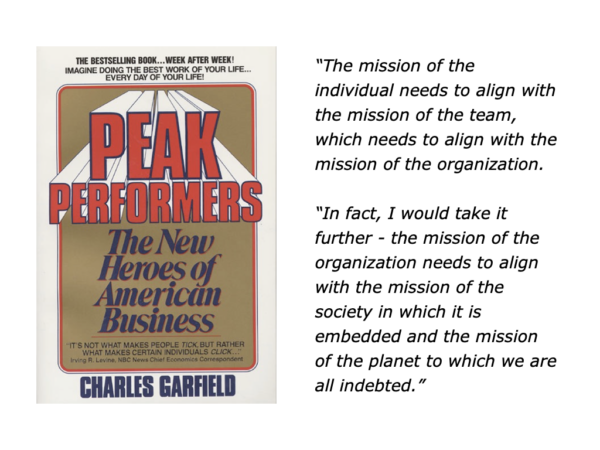
Different people follow different principles. Here are some that people may mention when describing those they want to follow in their work.
My Principles – The Principles I
Want To Follow In My Work Are:
To encourage other people … To create positive environments in which people can grow … To create beauty .. To deliver high quality work … To pass on knowledge that helps people to succeed.
Different people follow their principles in different ways. Mary Robinson, the former President of Ireland, believes in following the principle of kindness.
Whether the person is poor or a President, she shows warmth and tries to make the person feel the centre of her world. Mary explained this approach in her book Everybody Matters. This is followed by the official description of the book.
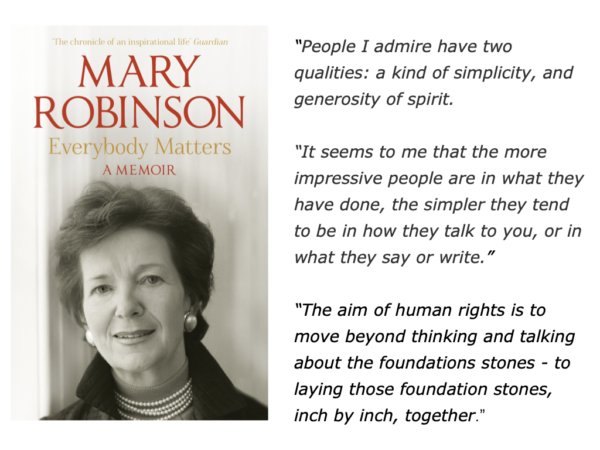
The first woman President of Ireland, who became UN High Commissioner for Human Rights, Mary Robinson has spent her life in pursuit of a fairer world.
Now, for the first time, she reveals what lies behind the vision, strength and determination that has helped her to achieve so much for human rights around the globe.
She describes the upbringing which gave her a strong sense of values and how she came into painful conflict with her parents – marrying against their wishes and, later, helping to legalise contraception in a deeply Catholic Ireland.
As a barrister she won landmark cases advancing the causes of women and the marginalised against the prejudices of the day. When – to the surprise of many – she became the first woman President of Ireland in 1990, she put Ireland firmly on the international stage.
Accepting the position of UN High Commissioner for Human Rights in 1997 was her biggest challenge and here she describes the huge political difficulties she encountered among the many triumphs.
Subsequently, based in New York, she led Realizing Rights for eight years, pioneering how to implement in practice economic and social rights: working in African countries on health, decent work, corporate responsibility and women’s empowerment in peace and security.
Mary now heads her Climate Justice foundation and works on behalf of the millions of poor people most affected by climate change.
Told with the same calm conviction and modest pride that has guided her life, Everybody Matters will inspire everyone who reads it with the belief that each of us can, in our own way, help to change the world for the better.
Let’s return to your own life. What are the principles you aim to follow in your work? If you wish, try tackling the exercise on this theme. This invites you to complete the following sentences.
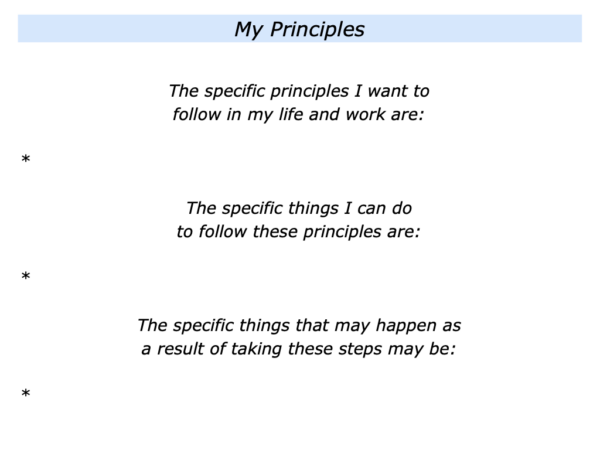
You Can Do
Your Personal Best
Great workers often aim to have a positive attitude, follow their principles and do their personal best. Different people do this in different ways. The following pages describe two people I have worked with who took this approach
Jacqui Smith – The
Birth Of Homesmiths
Jacqui uses her talents to create interior design for houses, care homes and retirement living. The following piece is one that Jacqui wrote many years ago. She and I met on a career development programme I ran for a travel company during the 1990s.
During our meetings we focused on her vocation. This was to create enriching environments. The following section describes how she moved from the marketing role she was doing to co-founding HomeSmiths with her husband David.
They started by doing work for friends and family on the weekends before going full-time. HomeSmiths has now been going for 20 years and moves from strength to strength.
Jacqui is now also a Regional Director for The Society of British & International Interior Design and Chair of the Haywards Heath Dementia Action Alliance.
Below is a recommendation from one of Homesmiths’ clients. It describes how they helped with the design of a Dementia Unit.

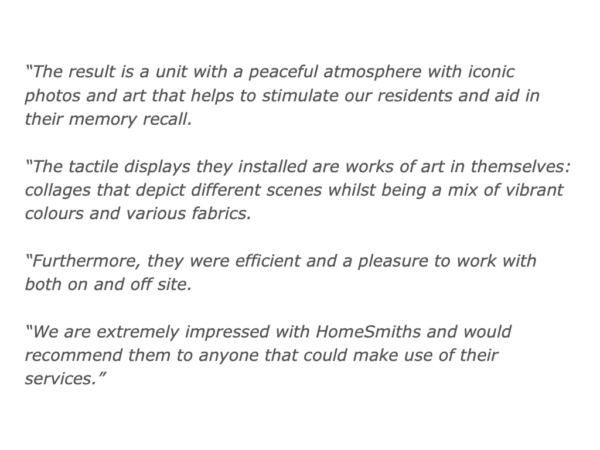
The Birth of ‘HomeSmiths’
As a child I could spend hours creating room sets for my dolls, fiddling with doll’s house furniture, making camps for my brother to play in or rearranging my bedroom.
Whilst I followed art and excelled at it through my childhood and teens, my school was fiercely academic. So when it came to ‘A’ Level choices, Art was dropped in favour of Economics, Maths and German!
University followed and I gained a degree in Economics and Maths. Having little clue of what I wanted to do, I found myself in sales and marketing, which is where I stayed for some years.
Feeling unfulfilled with my work, job changes ensued but I was never really addressing the root problem. Sales and marketing were not playing to my strengths.
This left a whole host of skills and, more importantly, passions untapped. Outside work I was continuing with more creative pursuits, such as designing room schemes for myself as well as friends and family.
But I never thought of doing this for a living, telling myself:
“I’m not trained in Interior Design – how could I make money from this and why would anyone take me seriously?” Imposter syndrome was real!
Despite constant encouragement from friends, I remained unhappy in the corporate world. I then attended a two-day workshop aimed at helping people to make a living doing what they loved.
Focusing on my passions, talents, dreams and goals threw up a common theme which simply read as:
‘Creating enriching environments.’
My husband David, a cabinet maker, had always wanted to run his own business – yet possessed none of the required sales, marketing or organisational skills. We also knew that one day we would set up on our own business.
David continued to design and make furniture in the short to medium term. In the longer term, however, he wanted to get more involved in bigger interior design projects.
I wanted to help people enrich their living environments with colour and texture – plus take on the challenge of running a business. A brainstorm and a bottle of wine later ‘HomeSmiths’ was born.
The name offers so much flexibility in terms of what we offer our clients. As our business has evolved over the years from residential and show home design to now predominantly care home and retirement living design, the brand works as well now as it did when we started.
When we started the business, the response from our immediate network was tremendous. Not only did people believe in the proposition, but truly believed in David and my ability, through our combined talents, to deliver.
Starting the business when our first child was four months old, people thought we were mad – but staying in our old roles was so much more frightening!
It has been hard work and we are still a young business, but we are building our reputation.
We work together incredibly well. Whilst David no longer makes furniture, he designs all the bespoke pieces for our projects and is responsible for managing our projects.
I lead on the design side and also the strategy and business planning. I always say that I could not run the business without David nor could he without me. It’s a great partnership that really works.
One lesson I learned on the workshop all those years ago was to network but, most of all, to give something back to people in your network.
So true and such a simple and cost effective way to grow a business! I can cite about ten key networking encounters which have shaped where we are today.
I believe that challenges also shape us. In 2012 I permanently lost the sight in my left eye.
Determined to combine my personal experience of sight loss with my profession, I have specialised in how the built environment can support people living with sensory and or cognitive decline.
I cannot think of a better interpretation of Mike’s observation at that workshop over 20 years ago, that my best work would focus around creating enriching environments. That is now exactly what I do.
I am evangelical about doing work you love and as a mother will certainly encourage my children to follow their natural paths in life and work.
Sue’s Story – Aiming
To Be A Good Parent
Sue Carter chose to shape her life in a positive way. In 1970 she came to the therapeutic community I was running for young people. Abandoned by her mother at the age of 2, she had grown up suffering abuse in institutions.
The community gave young people the chance to shape their futures. Sue recognised she was at a crossroads and began pursuing her chosen route.
In 2005, quite out of the blue, she emailed me to describe her journey over the past three decades. Sue was always feisty, which shines through her story.
Visited later in life by the Essex police who were investigating events at the children’s homes, the police asked if she was a victim of abuse. Sue declared:
“No, I am a survivor of abuse.”
Here is the piece she wrote about her journey.
My Aim To Be A Good Parent
My mother abandoned me and my two sisters in the park when I was two. During the next 14 years I moved from one children’s home to another.
Sometimes I was abused but I did not know anything else, so I thought it was normal. One housefather kept hitting me with his belt, so I yelled:
“Why are you hitting me?”
He said it was because I needed to show him respect. I yelled back:
“I’m not going to respect you if you keep hitting me.”
So he hit me harder.
One day I found myself in an institution that was famous for holding a girl who had killed a child. Looking back, I now realise that the only way I had kept my sanity was by rebelling, but it had got me into trouble.
Things looked bad, but then I got the chance to go to a community where young people like me had the opportunity to change their lives.
Over 30 years later I now have three sons and a wonderful granddaughter, who is the apple of my eye. The 30 years in-between have sometimes been difficult, but never dull.
After leaving the community I met a man and travelled around the world. Returning home, I began working in a children’s home.
Growing up in institutions myself, I knew what the children needed and tried to help them to feel safe and loved. Even if I say it myself, I found that I was good with children.
During my twenties I had several long relationships and eventually got married.
Unfortunately my husband tried to control me. Even if I was going to Sainsbury’s, he wanted to know what I was doing. I was never one to let anyone control me, so end of marriage.
Eventually I realised that I didn’t have good relationships with men because I tested them to the limit. So I wasn’t shocked when they didn’t reach my expectations. And, of course, I also made some bad choices.
My greatest fear as a parent was that my kids could end up in care. So I then decided to be the best single parent I could be.
This meant relationships with men were out. I stayed on my own with the boys for the next 18 years.
Then I met a good man with whom I had a child. Even though the man and I have now parted, we are still good friends and he is a good father.
Looking back at my time in the community, I am so happy that I was given the opportunity to meet people who taught me it was okay to talk about things.
So much pain was bottled up inside me from the years spent in care and the abuse that I and my sisters suffered. I was one of the lucky ones.
I found a way to confront my demons, talk about them and they stopped hurting.
About 10 years ago my sisters and I were contacted by the police about the abuse we experienced in children’s homes.
The police came to my house and met with me and my sisters and asked if we were victims of abuse. I stood up, faced the policeman and said:
“NO, I AM A SURVIVOR OF ABUSE.”
Then I realised I had got rid of my demons. Some people never get the chance to rid themselves of past problems.
Looking back, the community showed there were people who could look after kids, value their opinions and not resort to abuse.
The community made us feel safe and we never betrayed that trust. Some newcomers tried to bring drugs into the house, but we said:
‘Don’t bring that stuff here. If you want to take drugs, leave the community.’
Sometimes we had fantastic talks. There would be eight of us sitting in a bedroom till midnight, just sharing thoughts we had never discussed with anybody before.
Every young person in the community had suffered problems. We encouraged each other to talk about the past, but didn’t allow each other to use it as an excuse for behaving badly.
If I said, ‘My mother left me in the park when I was two,’ somebody else said: ‘I can top that. How can you use that bad experience to help others in the future?’
Suddenly I realised that I didn’t have to go on the path I was hurtling along, which would probably have led to drugs or prison.
The people in the community believed in us and my feelings mattered. Someone listened when I was screaming. What could be more wonderful than that?
Nowadays I try to help other people by volunteering to work at the local hospice. But the thing I am most proud of is being a good parent to my children.
Different people choose different ways to do their personal best. The following pages describe exercises that people can use to follow this approach.
The Positive History Approach
This is an approach used in sports and other fields. It invites a person to learn from their positive history and go through the following steps.
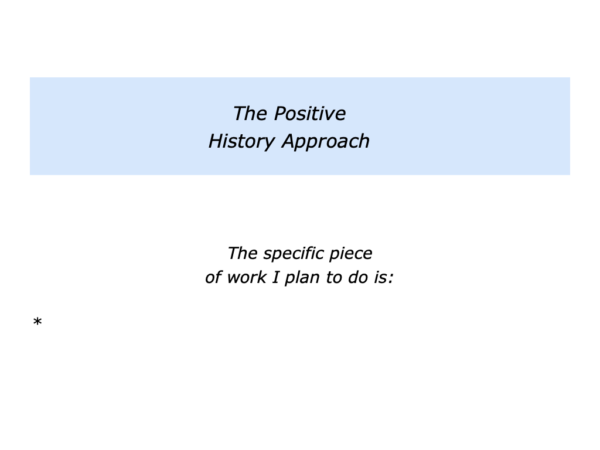
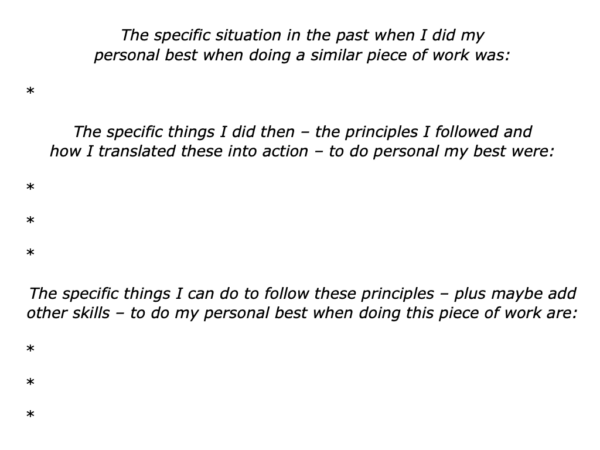
The Positively Engaged Approach
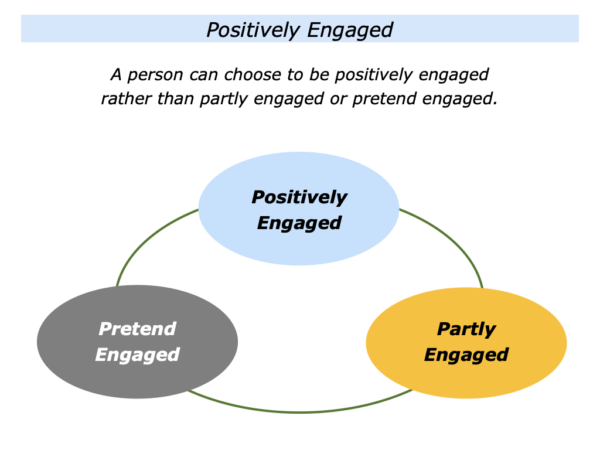
People often do their best work when they are positively engaged rather than partly engaged or pretend engaged. Sounds obvious, so how can you translate this into action? Let’s explore these three kinds of engagement.
Positively Engaged
What are the activities in which you feel positively engaged? What are your doing right then? What are the principles you are following? How do you translate these into action?
You may have a positive attitude and prepare properly. Moving into action, you may feel alive and alert. You may use your whole being to focus fully on the situation and work towards the desired picture of success.
Partly Engaged And Pretend Engaged
When do you feel partly engaged? Sometimes you are interested, sometimes you are not. The feeling is:
“I could be spending my time doing something more worthwhile.”
How do you behave then? What are the consequences – both for you and for other people – when you behave this way? Let’s explore some of your options.
You can try to avoid putting yourself into situations where you feel partly engaged, but sometimes this can be difficult. Bearing this in mind, how can you manage the situation?
One approach is to plan ahead and decide how you want to behave in the situation. If appropriate, it is to ask yourself:
How can I be professional? How can I play a positive role and support other people? How can I make a positive contribution in the situation?
This can work for a while, but you will need to prepare properly and rehearse how you will behave in the situation. Sometimes you may need to buy time and not react to triggers that can send you into a negative spiral.
What are the activities in which you feel pretend engaged? You feel uncomfortable, unreal and must make a real effort to appear professional.
Something bugs you. Maybe it is the values of the people or the company. Maybe you don’t believe in what they are doing.
Nevertheless, you summon-up energy to do your best, but afterwards you may get headaches or other symptoms. Continually putting yourself in these situations can have consequences for your health.
Looking ahead, how can you put aim to be positively engaged? This can bring benefits for both yourself and other people. One manager described how they tackled this challenge.
“Looking back at my work pattern, I found that I felt positively engaged only 20% of the time. This was having an effect on both my personal and professional life. Looking to the future, I decided to do three things.
“First, to list the activities in which I felt positively engaged. These included selling to certain kinds of customers. Second, to spend more time doing these things. Third, to show the business case for doing these things by getting some quick wins.
“This approach proved successful. I began to put together the high points like a string of pearls across the week. Within six months I was spending 80% of my week doing stimulating work that brought benefits to the company.
“There are still some meetings where I feel partly engaged, but I try to be professional and make a positive contribution. I feel much happier in both my personal and professional life.”
Some athletes, for example, continually aim to be positively engaged. They aim to stay in the moment and be fully present. This often works, but sometimes they hit setbacks.
Some use a personal mantra – something they say to themselves – to recentre. They then aim to regain their rhythm and do their best to deliver the desired results.
The Daring To Be
Imperfect Approach
Olivia Hurley, an assistant professor and sports psychologist, described elements of this approach in her article What We Can Learn About Resilience From Elite Athletes. Here is an excerpt from the article.
Have The Courage To Be Imperfect
Too often in life, we aim for ‘perfection’.
As sport psychologists we should not recommend athletes use this term.
Instead we should work together to help them to produce Personal Bests (PBs), helping them to aim for performance excellence, but not expecting perfection.
Such PB targets should not stop anyone from giving one hundred per cent effort to their performances.
But, by not feeling the need to be perfect, they are more likely to ‘have a go’, which often leads to the most effective performances.
Jeremy Snape, a sports psychologist, described how it is important to be fully committed rather than worrying about being perfect. He explained this in the following way.
“Perfectionism can be good for driving your work ethic and your attention to detail. But it can also cause stress, procrastination and even avoidance – because you’re afraid of not achieving it.
“The really great sportspeople have the courage to throw themselves into any endeavour with 100% commitment, knowing that it’s going to be imperfect.”
There are many ways to do fine work. One approach is to play to your strengths, follow your principles and do your personal best.
Looking ahead, can you think of a situation where you may want to follow elements of this approach? How can you do this in your own way?
If you wish, try tackling the exercise on this theme. This invites you to complete the following sentences.
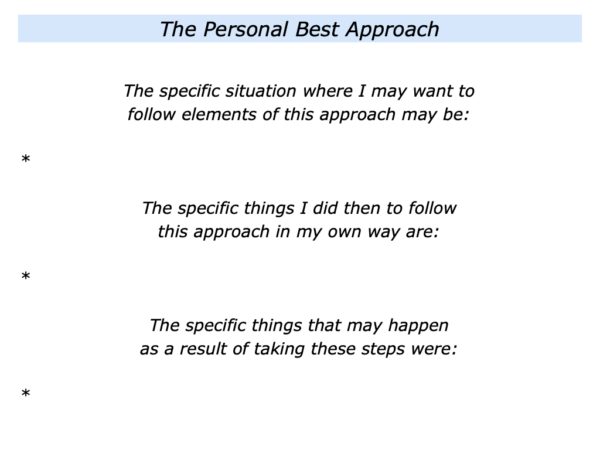

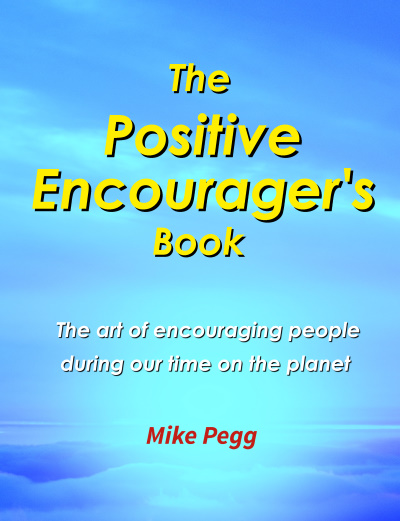




Leave a Reply